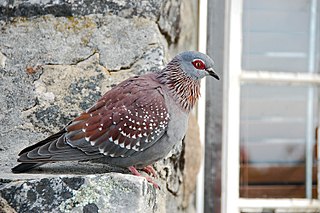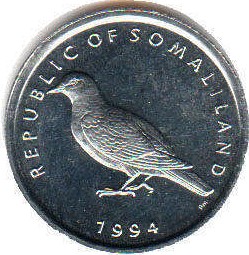
Columbidae is a bird family consisting of doves and pigeons. It is the only family in the order Columbiformes. These are stout-bodied birds with short necks and short slender bills that in some species feature fleshy ceres. They primarily feed on seeds, fruits, and plants. The family occurs worldwide, but the greatest variety is in the Indomalayan and Australasian realms.

The rock dove, rock pigeon, or common pigeon is a member of the bird family Columbidae. In common usage, it is often simply referred to as the "pigeon".

The stock dove is a species of bird in the family Columbidae, the doves and pigeons. It is widely distributed in the western Palearctic.

The common wood pigeon or common woodpigeon, also known as simply wood pigeon, wood-pigeon or woodpigeon, is a large species in the dove and pigeon family (Columbidae), native to the western Palearctic. It belongs to the genus Columba, which includes closely related species such as the rock dove. It has historically been known as the ring dove, and is locally known in southeast England as the "culver"; the latter name has given rise to several areas known for keeping pigeons to be named after it, such as Culver Down. It has a flexible diet, predominantly feeding on vegetable matter, including cereal crops, leading to them being regarded as an agricultural pest. Wood pigeons are extensively hunted over large parts of their range, but this does not seem to have a great impact on their population.

The large bird genus Columba comprises a group of medium to large pigeons. The terms "dove" and "pigeon" are used indiscriminately for smaller and larger Columbidae, respectively. Columba species – at least those of Columba sensu stricto – are generally termed "pigeons", and in many cases wood-pigeons. The rock dove, has given rise to the majority of domesticated pigeon breeds, such as the racing pigeon and the fantail pigeon some of which have become feral. Meanwhile, "wood pigeon" by itself usually means the common wood pigeon.

The speckled pigeon, or (African) rock pigeon, is a pigeon that is a resident breeding bird in much of Africa south of the Sahara. It is a common and widespread species in open habitats over much of its range, although there are sizable gaps in its distribution. It is sometimes referred to as the Guinea pigeon due to its similar coloring to some species of guineafowl.

The Bonin wood pigeon was a pigeon endemic to Nakodo-jima and Chichi-jima in the Ogasawara Islands, south of Japan. It is known from four recorded specimens, the first from 1827 and the last from 1889. They averaged a length of 45 cm. This pigeon died out late in the 19th century as a result of deforestation, hunting, and predation by introduced rats and cats.

Ocotea is a genus of flowering plants belonging to the family Lauraceae. Many are evergreen trees with lauroid leaves.

The afep pigeon, also known as the African wood-pigeon or gray wood-pigeon, is a member of the family Columbidae which lives in the Equatorial Forests of Africa.

The speckled wood pigeon is a medium-sized pigeon of the family Columbidae which lives in montane forests of Kashmir to Northeast India, eastern Tibet, central China, Yunnan and Myanmar.

The African olive pigeon or Rameron pigeon is a pigeon which is a resident breeding bird in much of eastern and southern Africa from Ethiopia to the Cape. Populations also are found in western Angola, southwestern Saudi Arabia and northern Yemen. It is locally common, although sizeable gaps in its distribution occur due to its habitat requirements.
Ring dove is an alternative name for the Barbary dove. It may also refer to:

The Somali pigeon or Somali stock dove is a species of bird in the family Columbidae. It is endemic to Somalia. Because there has hardly been any research on the species, the health of the population is uncertain; however, it is believed that the species is relatively rare. The IUCN Redlist identified a possible threat to the species from the speckled pigeon. C. oliviae is found mostly on the ground, where it often forages, most frequently in rock along arid coasts.

The blue-spotted wood dove is a species of bird in the family Columbidae. It is abundantly present throughout Africa south of the Sahel; it is partially present in East Africa and absent in southern Africa.

Haemoproteus is a genus of alveolates that are parasitic in birds, reptiles and amphibians. Its name is derived from Greek: Haima, "blood", and Proteus, a sea god who had the power of assuming different shapes. The name Haemoproteus was first used in the description of Haemoproteus columbae in the blood of the pigeon Columba livia by Kruse in 1890. This was also the first description of this genus. Two other genera — Halteridium and Simondia — are now considered to be synonyms of Haemoproteus.
Wood pigeon, wood-pigeon or woodpigeon may refer to:
Rock pigeon may refer to:

The Azores wood pigeon, Columba palumbus azorica is an endemic subspecies of the common wood pigeon, located in the Atlantic Azores islands of Portugal. This endemic subspecies is the only live pigeon present in the laurel forest habitat of the Azores Islands.
Speckled Wood may refer to:
This page is based on this
Wikipedia article Text is available under the
CC BY-SA 4.0 license; additional terms may apply.
Images, videos and audio are available under their respective licenses.














